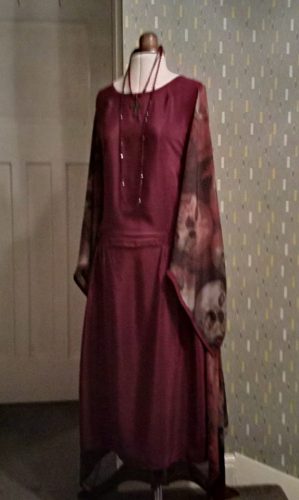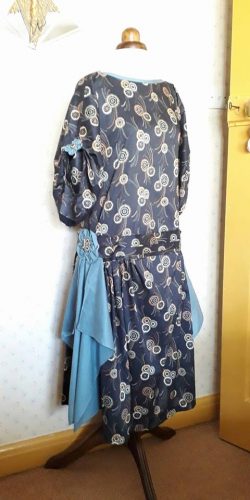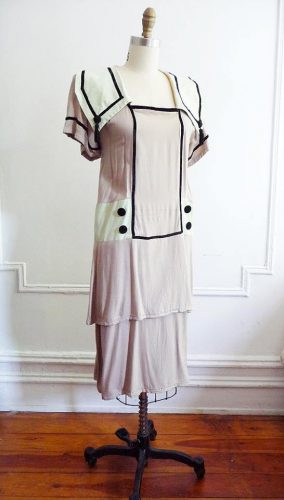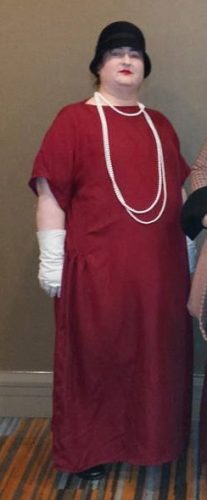You can make a 1920s Gatsby tea party dress quickly with the “One-Hour Dress” pattern. Here are tips to help turn your 1920s one-hour dress from boring to beautiful.
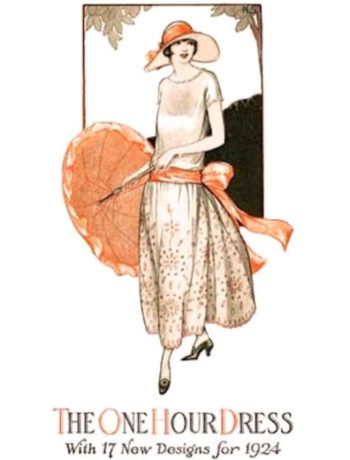
1924 One-Hour Dress Pattern eBook
In the summer of 2009, I was making plans to attend The Great Gatsby Festival and Tea in South Lake Tahoe, CA. I had many costumes in my closet, but surprisingly I did not have any in the 1920s style (this was before VintageDancer was born).
The book, The Great Gatsby, takes place in 1922, one year before the “flapper” revolution. Making a fringed and feathered flapper dress for a daytime tea party would have been inappropriate. Ladies’ day dresses were long, straight, and fairly conservative – the complete opposite of a flapper girl.
I looked at all my local vintage thrift stores for dresses from the ’20s as well as looking at sewing patterns at JoAnn fabric and Hancock Fabrics (my favorite fabric stores). No luck.
Then, I turned online and found the 1920s “One Hour Dress” booklet. A seamstress wrote this 17-page instruction manual in 1924. Her idea was to show women how to make a very simple frock dress in less than an hour — enough time to make a new dress for each garden party you are invited to. Sounds perfect.
I purchased the pattern and after reading through the directions and looking at each of the 17 variations, I decided to make the dress on the cover. The wispy skirt blowing in the breeze with a long pink sash trailing behind it captured the romantic simplicity a young ’20s girl ought to be.
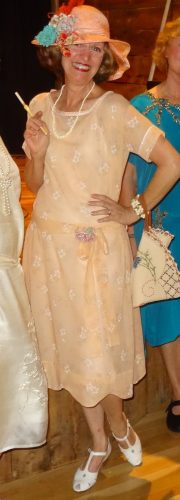
Peachy keen One Hour Dress made by Susan R.
How I Made My One Hour Dress
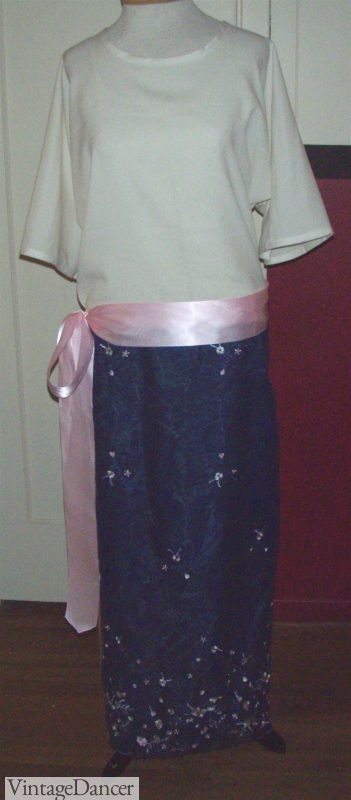
My first One Hour Dress
The first step was to take my measurements. I am not good with numbers, so this part took me a while. The directions show you how much fabric you will need to buy based on your measurements. They assume you are making the dress out of the same fabric rather than making the top and bottom different.
I measured how long the top and skirt needed to be, added a little extra “just in case,” and went shopping for fabric.
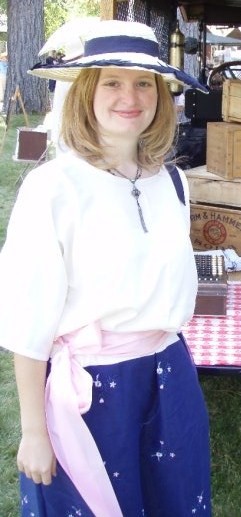
1920s One-Hour Dress
For the skirt, I found a beautiful navy chiffon material with colorful embroidered flowers. Since the fabric was sheer, I picked a navy cotton blend to act as the lining.
For the top, I found a cream polyester blend material with a bit of a crepe texture to it. It was soft and flexible. Most fabrics during the ’20s were flexible, not stiff, so that they hugged the body naturally.
Finally, the sash was a long piece of pink satin ribbon about 6 inches wide.
Tips for Making Your One-Hour Dress
Here are a few lessons learned while making the one hour dress, from myself and a few lovely ladies from the 1920s-1930s Costumers Support Group (Facebook).
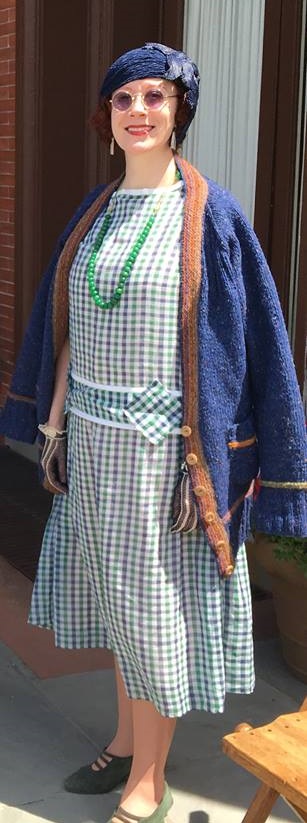
Eileen K. Cotton check day dress trimmed in vintage bias tape.
- The cutting and sewing directions were easy to follow. They are not written in modern English, so you may have to read each line a few times and look at the illustration before figuring out what to do. If you have no sewing experience, you might need some experienced help.
- Do not over-estimate your size. I was nervous about the top and especially the sleeves fitting too tight (I have fat arms), so I added an extra inch to the measurements. Do not do this. I and several other people who have used this pattern found it ran big. If you are petite, you may want to cut the sleeves shorter and reduce the width of the neck hole (just be sure to leave it big enough to fit over your head). The same goes for the dress bottom- do not add extra inches. Even my second one hour dress was too big. You WILL need to make adjustments.
- Make your measurements AFTER you figure out your undergarments. Always test try on your dress over them, too. Especially if you want to wear authentic or 1920s inspired lingerie, your measurements will change. “Having the proper undergarments can take the outfit from okay to wow, and I was surprised by how comfortable I was, even when wearing four layers of clothing (camiknickers, girdle, slip and dress)”- Jackie. W
- If you are making one of the 17 variations, read those directions first and figure out where in the basic directions you need to make adjustments. Jackie W says “ALWAYS do a muslin. While I describe the dress as a big sack, you do still need to figure out what measurements work best for your body type (and I wasn’t about to waste my expensive silk!) I had a bit of an advantage as I have made Greek peploses for my other historical recreation hobbies, but I still had to tweak a few things.”
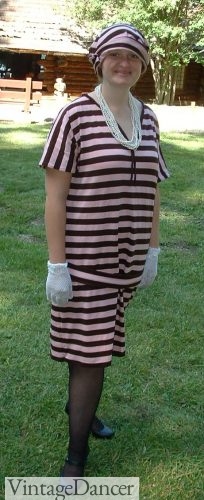
My one Hour Dress made of a pink and brown knit. (It looked better on the mannequin. I swear!)
- Fabric choice will make or break this pattern. If you want a “peasant” look, you can use a cheap cotton blend, otherwise spend a bit more and get a middleweight fashion fabric, jersey, wool blend, or poly-cotton blend. Lighter fabrics such as cotton voile or lawn, silk, and some rayons can also be used, but you may need to wear a slip underneath sheer fabrics. Be careful about 100% polyester if you are wearing this dress in a warm climate. Polyester does not breathe and you will get hot and sweaty very fast. Also, be cautious of knit fabric. My second dress is made of knit. Knit is evil to work with, but it still turned out pretty, except the hat. That was a mess.
- Spruce up your dress with details. The basic one-hour dress is just that: basic. Especially if your top and bottom are the same fabric, you will want to add some trim, pockets, sash, embroidery, or another decorative element. Look at images of 1920s afternoon dresses or plus size dresses or this Pinterest board for decorating ideas. ” It definitely takes more than an hour if you want it to have any embellishment! But it’s fun and easy, good for beginners who feel intimidated by historic patterns.” – Heather Q.
You can also leave the dress plain but add accessories like jewelry, a cloche hat, gloves, purse, shoes, and stockings. - This pattern was designed to make a frock – a day dress – however it can easily be made into evening wear. Use beaded chiffon, silk, light velvet, or satin fabric (Indian sari is great!). Add extensive embellishments and top it off with high-end jewelry and accessories.
- Since this pattern was made in 1924, the design is not your typical short flapper dress with a formless but more fitted design. For a later ’20s pattern by the same author, use Pretty Frocks the Easy Way. The designs have more unique skirt shapes, pintucks, pleats and design details than the tunic shaped One Hour Dress. I actually like the Pretty Frocks pattern a little better, yet it is just as easy to use as the One Hour dress pattern. My blue handkerchief hem dress below was made with Pretty Frocks. I wore it again when I was 8.5 months pregnant, but this time I added accessories to give it more dimension. Read about all the ways you can accessorize a plain 1920s dress here.
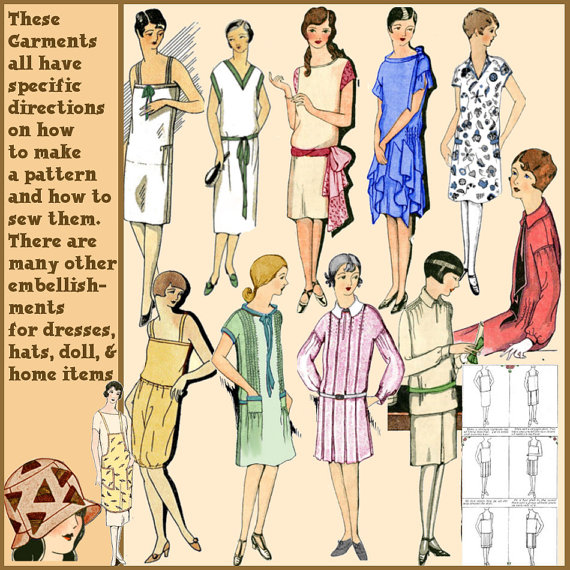
1929 Pretty Frocks the Easy Way booklet ( I used the blue dress as my pattern.)
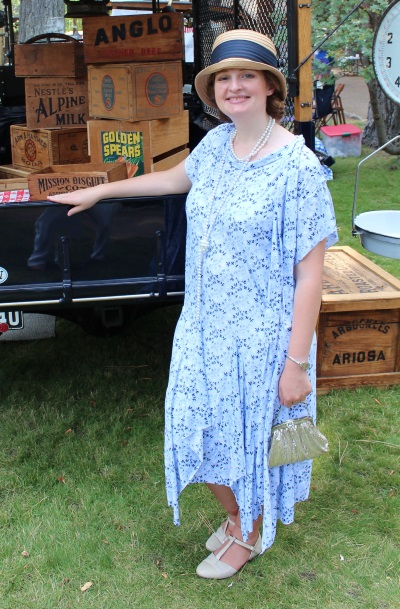
My dress made from the Pretty Frocks booklet
More examples of One Hour Dresses:
(Include yours here, just ask the VintageDancer!)
- A silk One hour dress using a scarf for the sleeves. Made by Pandora H.
- . Cotton Dress made by Pandora H
- A One Hour Dress trimmed to perfection! Made by Heather W.
- One Hour Evening Dress. Isn’t it fabulous! – Made by Jackie W.
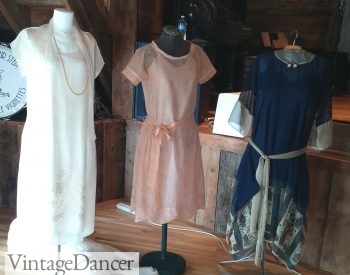
Three lovely One Hour Dresses
The 1920s one-hour dress pattern is one of the most useful patterns I have found online in a long time. The pattern is easy and the variations are endless. Although I have only made one two dresses to date, I am planning to make several more – for both day and evening wear. After your first dress, you will have a good understanding of the pattern and its potential to make dresses that will “wow” all the guests at your next party. Pick up your copy of the One Hour Dress and get sewing!
Or find more 1920s dress patterns here and DIY costume ideas here or here. You may also like how I modified a modern pattern to make a 1920s house dress, too. There are so many options to DIY your way to a great 1920s dress!
Debbie Sessions has been teaching fashion history and helping people dress for vintage themed events since 2009. She has turned a hobby into VintageDancer.com with hundreds of well researched articles and hand picked links to vintage inspired clothing online. She aims to make dressing accurately (or not) an affordable option for all. Oh, and she dances too.
